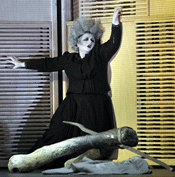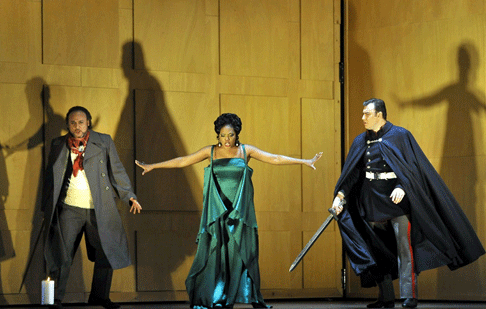08 Jan 2010
Quality opera just round the corner
Well into the 1960s, ‘provincial theaters’ were the backbone of Italy’s operatic culture.

Well into the 1960s, ‘provincial theaters’ were the backbone of Italy’s operatic culture.
Typically seating 200 to 600, offering reduced seasons of just a few popular titles, hosting strolling companies and partly drawing from semiprofessional forces as to orchestras and choirs, they worked as an efficient low-entry circuit nationwide, so that young talents might be discovered and acquire stage experience, while mature professionals could age gracefully while waiting for retirement.
That pattern went nearly lost during the following decades, as growing travel opportunities on one side, and multimedia diffusion of grand opera productions on the other, compelled many a minor house to shut up shop. However, part of it is resurfacing in a more sophisticated form. Aware of unavoidable competition from opera DVDs and cheap live beaming in neighborhood cinemas, provincial opera theaters now reopen under the aegis of local Councilors for Culture and Education, putting a premium on artistic quality rather than on business, albeit within the constraint of limited public budgets.
Padua’s Teatro Comunale, named for Giuseppe Verdi, is one such example. “Less is more” is the motto for this small but savvy house that offers two productions a season, with fashionable directors, elegant but essential sets and emerging musical talents from the world over. Coproductions with its peers in the area, Rovigo and Bassano del Grappa, multiply the impact and grant Padua denizens the experience of live opera just round the corner — for ludicrous investments. This lovely production of Trovatore, for example, did cost the local taxpayer a mere Euro 105,134.06 — all included.
 Anna Smirnova as Azucena
Anna Smirnova as Azucena
It updates the action from Medieval Spain to some unspecified episode of modern class warfare, or, according to the director’s notes, to the days of Resistenza, the anti-Nazi guerrilla in Italy during the 1940s. While the consistency of this metamorphosis remains questionable under several viewpoints, it allows director Denis Krief — in charge of costume design as well as of sets and lighting — to contrast the rival parties by outfitting Count di Luna and his troopers in military uniforms resembling an early version of today’s Italian Polizia di Stato and Manrico’s forces (including the hard-working Gypsies) in casual civilian clothing. Simple, clear and low-budget enough. Both Leonora and her lady-in-waiting Ines wear elegant evening gowns befitting their social rank; as to Azucena, she stands midway between a punk star and the German diva Brigitte Helm featuring the Whore of Babylon in the 1927 cult movie Metropolis.
Even though the stage is rather large, Krief uses the space well and moves his people within the framework of a gigantic book, whose wooden pages, around 5.50 meters tall, are meant to remind that Verdi’s gloomy narration is both historic and a fairy tale. Their diversely carved surfaces, turned by the stagehands after each scene, also provide an ever-changing enhancement to the hall’s acoustic. Sound wizardry through a frugal technology not involving any electronic equipment.
 Vitaliy Biliy as Conte di Luna, Walter Fraccaro as Manrico and Kristin Lewis as Leonora
Vitaliy Biliy as Conte di Luna, Walter Fraccaro as Manrico and Kristin Lewis as Leonora
Conductor Omer Meir Wellber clearly appreciates how fine an orchestrator Verdi was, as I heard many woodwind colors that often go overlooked, while the strategic role of the offstage choir and band was given due prominence. The young Israeli maestro, still in his late twenties, is a wonderful talent. His debut at Padua, in late 2008 with Aida, got him no less than the Toscanini Award from the Italian association of music critics. A similar story to Kristin Lewis’, a budding soprano from Little Rock, Arkansas, whose appearance as Aida on said production won her a row of international invitations for the same role. From her first phrase as Leonora she gave the impression of an almost ideal Verdian performer — indeed her ample, soft-grained lyrical tone and generous chest notes made her singing the delight of the evening.
As Azucena, the Russian mezzo Anna Smirnova impressed with her vast range of vocal color and dramatic accents of uncommon intensity. Ferrando, a somewhat perfunctory character who opens the opera by explaining the background that sets the plot in motion, then practically disappears, was impersonated by Roberto Tagliavini. With his big, solid voice and strong stage presence, he offered a preview of the vocal treasures he has in store, leaving me with the desire to hear more.
The two leading men, tenor Walter Fraccaro as Manrico and Ukraine’s baritone Vitaliy Biliy as Count di Luna, are both good singers who interpret their roles with much ardor. Both have some dramatic shortcomings, though. In Biliy’s case the problem lies in acting. Even though he’s tall and commands the stage as a military leader should, his gestures are stock, failing to convey the character’s moments of doubt, brief repentance, and final desperation.
Carlo Vitali